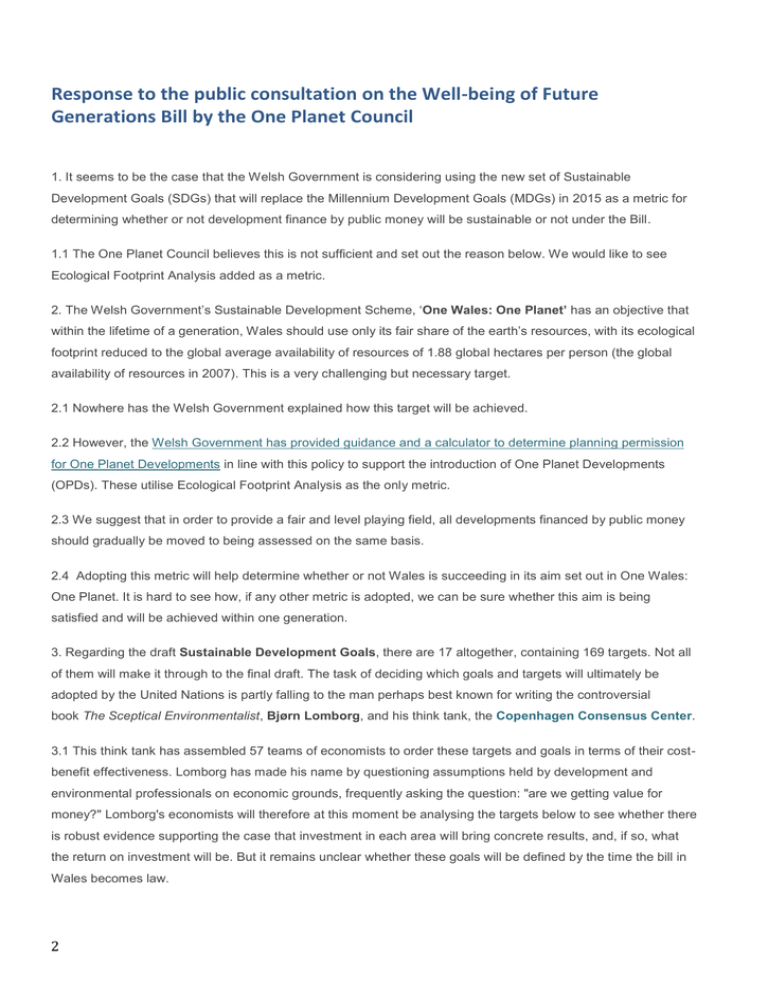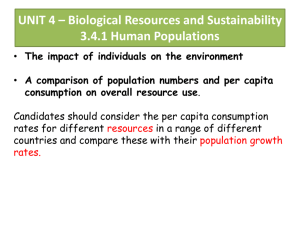Response to the public consultation on the Well
advertisement

Response to the public consultation on the Well-being of Future Generations Bill by the One Planet Council 1. It seems to be the case that the Welsh Government is considering using the new set of Sustainable Development Goals (SDGs) that will replace the Millennium Development Goals (MDGs) in 2015 as a metric for determining whether or not development finance by public money will be sustainable or not under the Bill. 1.1 The One Planet Council believes this is not sufficient and set out the reason below. We would like to see Ecological Footprint Analysis added as a metric. 2. The Welsh Government’s Sustainable Development Scheme, ‘One Wales: One Planet’ has an objective that within the lifetime of a generation, Wales should use only its fair share of the earth’s resources, with its ecological footprint reduced to the global average availability of resources of 1.88 global hectares per person (the global availability of resources in 2007). This is a very challenging but necessary target. 2.1 Nowhere has the Welsh Government explained how this target will be achieved. 2.2 However, the Welsh Government has provided guidance and a calculator to determine planning permission for One Planet Developments in line with this policy to support the introduction of One Planet Developments (OPDs). These utilise Ecological Footprint Analysis as the only metric. 2.3 We suggest that in order to provide a fair and level playing field, all developments financed by public money should gradually be moved to being assessed on the same basis. 2.4 Adopting this metric will help determine whether or not Wales is succeeding in its aim set out in One Wales: One Planet. It is hard to see how, if any other metric is adopted, we can be sure whether this aim is being satisfied and will be achieved within one generation. 3. Regarding the draft Sustainable Development Goals, there are 17 altogether, containing 169 targets. Not all of them will make it through to the final draft. The task of deciding which goals and targets will ultimately be adopted by the United Nations is partly falling to the man perhaps best known for writing the controversial book The Sceptical Environmentalist, Bjørn Lomborg, and his think tank, the Copenhagen Consensus Center. 3.1 This think tank has assembled 57 teams of economists to order these targets and goals in terms of their costbenefit effectiveness. Lomborg has made his name by questioning assumptions held by development and environmental professionals on economic grounds, frequently asking the question: "are we getting value for money?" Lomborg's economists will therefore at this moment be analysing the targets below to see whether there is robust evidence supporting the case that investment in each area will bring concrete results, and, if so, what the return on investment will be. But it remains unclear whether these goals will be defined by the time the bill in Wales becomes law. 2 3.2 But there are, we suggest, at least two areas in which taking a purely economic perspective will lead to skewed results from other perspectives. Many of the Sustainable Development Goals contain reference to the need to protect vulnerable individuals such as the old and infirm or children, but these people do not have the same level of economic value as a fit, healthy young adult. A purely economic argument would place less value on preserving their lives. 3.3 And in dealing with issues of biodiversity, is it right to place only economic value upon species and ecosystems, the so-called 'natural capital', in order to justify preserving them, or should they not be preserved purely for their own sake? Can sustainable development be truly sustainable if it takes an exclusively anthropogenic perspective? 4. The One Planet Council would like to see Ecological Footprint Analysis (EFA) used as an indicator instead or as well as the SDGs. EFA, again, is an economic analysis. Nevertheless it has the advantages of being absolute and a proxy for other benefits, not an economic end in itself. Ecological Footprint Analysis and absolute sustainability indicators 5. Many of the targets contained in the SDGs are relative, calling for a percentage reduction in this or that, which is a reasonable way of measuring some types of progress, but only if the baseline is selected appropriately. 5.1 To take the example of climate change, the numbers we should be focused on are absolute ones, such as the degree of concentration of greenhouse gases in the atmosphere. While we can reduce our emissions in a proportionate sense, it is this final absolute concentration figure that matters, because upon that rests the degree of warming that will occur. 5.2 To take another example, that of energy efficiency in buildings, the Passivhaus standard is an absolute and measurable metric and enables comparisons between buildings, whereas targets that are often found in building regulations, based on a percentage reduction in energy use, do not enable this and are less likely to result in genuine reductions in greenhouse gas emissions and energy use. 6. With this in mind, Ecological Footprint Analysis uses expenditure as a proxy for ecological damage (just as, reciprocally, the number of human lives lost through, say, disease or traffic accidents, can translate into an economic cost). It does this, however, without putting a value on the environment. That is not necessary: all we need to know is that consumption involves the use of resources, and consumption involves expenditure. 6.1 Ecological footprint analysis can be applied to individuals, households, developments, towns and countries. By comparing the results we can not only adjudge their relative performance in environmental sustainability terms, but also, in conjunction with economic and other indicators, a ratio of environmental efficiency. 7. To decouple well-being from environmental impact should be a chief goal of sustainable development, making it possible for people to live better and more fulfilling lives, with everything they need, at minimal cost to the environment. 3 7.1 So, even though Lomborg and his 57 teams of economists will come up with financially quantitative analyses of the 169 targets, ranking them in terms of cost-effectiveness, there will still remain the qualitative and valueladen task of choosing how to weight the results, before we can arrive at the final, definitive list. 8 We recommend that there is a need for further research underpinning Ecological Footprint analysis as used in Wales and elsewhere. 8.1 Results are coming in from existing one planet developments which need to be analysed to determine what works and what does not work so the process can become more efficient. 8.2 The calculations using the calculator need to be continually examine and refined. 8.3 This work could be undertaken by, or financed by The Welsh Government and conducted by the expertise already in place in the Cardiff Business School and the Geography Department of Cardiff University. 9. We recommend that with ecological footprint analysis used as a metric, that there is a staggered or incrementally reducing series of targets for reducing the ecological footprints of developments financed by public money over 25 years (one generation). This is because in many cases initially adopting such a radical level of reduction as 1.88 global hectares per person will not be possible immediately. 9.1 (It's worth noting that even this low level, while difficult to achieve, is still not as low as it should be in order for every person on the planet's equally share the total of humanity's ecological impact.) 4



